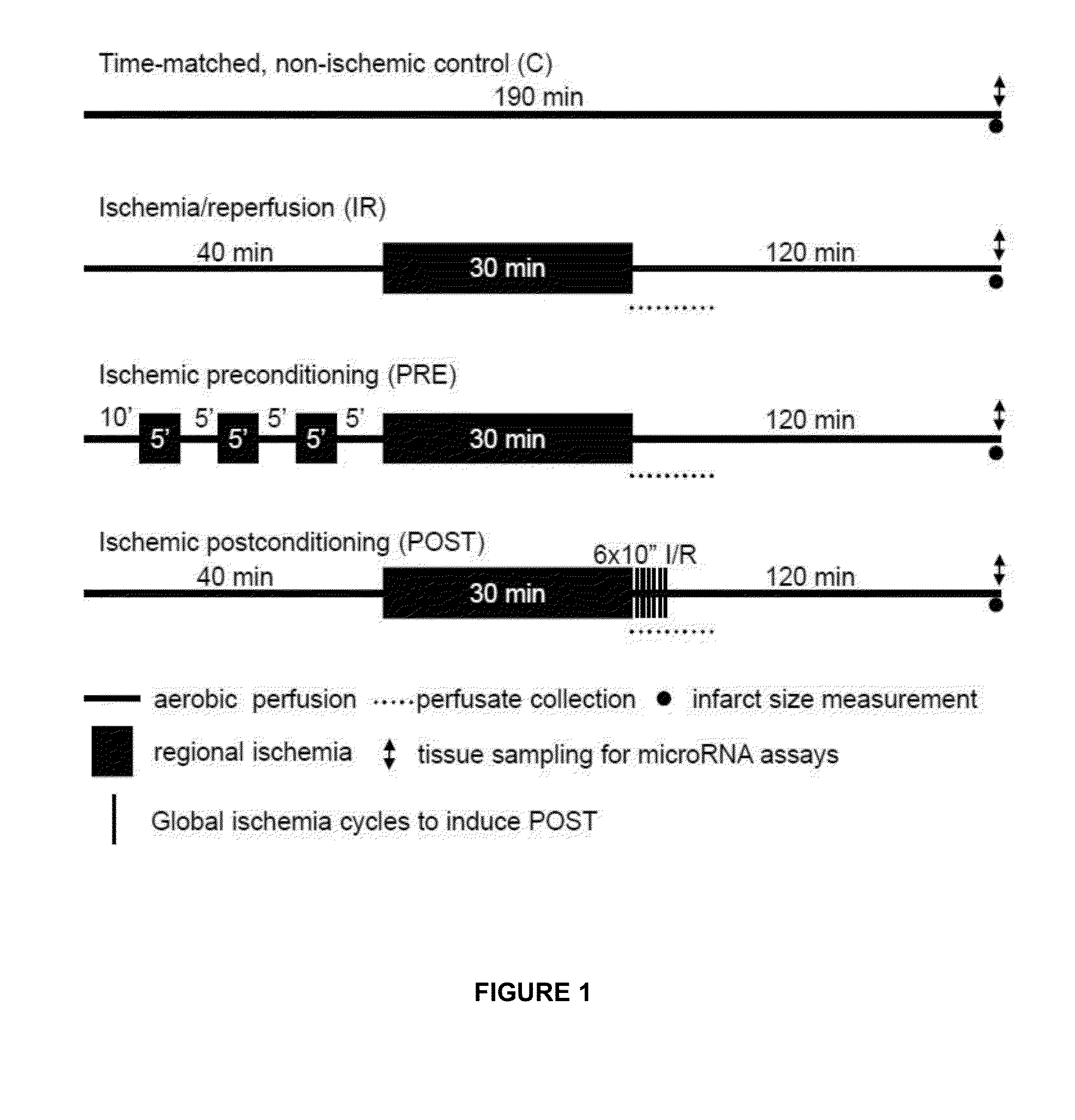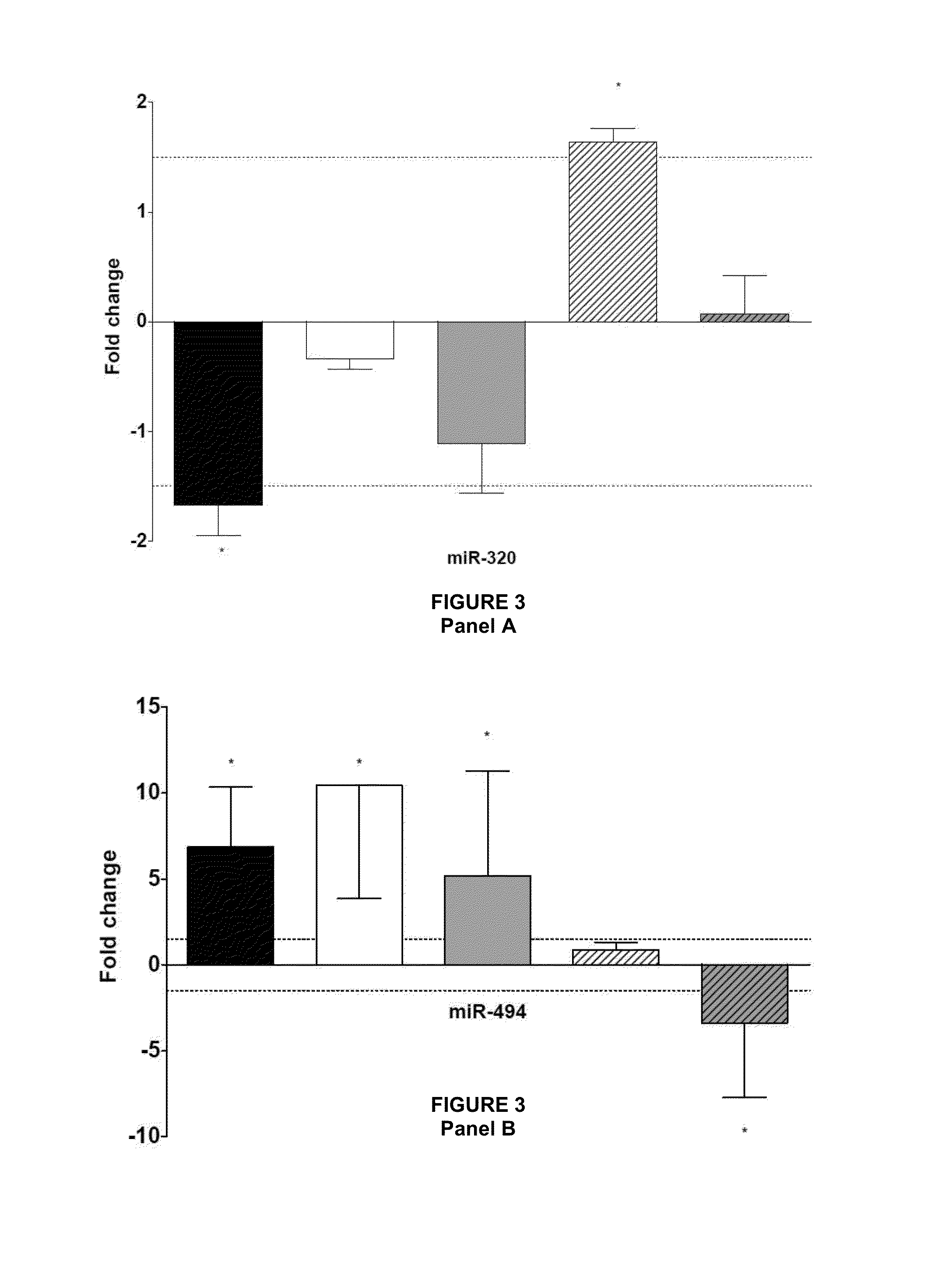Compounds for the treatment of ischemic injury
a technology for ischemic injury and compound, applied in the field of compound for the treatment of ischemic injury, can solve the problems of tissue that no longer receives adequate blood flow, dies within a few hours, and is not known,
- Summary
- Abstract
- Description
- Claims
- Application Information
AI Technical Summary
Benefits of technology
Problems solved by technology
Method used
Image
Examples
example 1
Identification of MiRNAs Involved in Ischemia-Reperfusion Injury
[0464]To determine miRNAs involved in ischemia-reperfusion injury, preconditioning and postconditioning miRNAs were isolated from the anterior wall of left ventricles after two hours of reperfusion. The relative changes in miRNA expression after ischemia-reperfusion were determined using the time-matched control group as baseline. In response to ischemia-reperfusion, approximately 150 miRNAs showed expression among the total 350 rat miRNAs studied. We have confirmed the microarray data by measuring the expression of 17 randomly selected miRNAs using QRT-PCR. Expression changes of 15 miRNAs were confirmed by QRT-PCR (Table 2).
[0465]To demonstrate whether cardioprotective adaptation leads to alterations of miRNA profile in the myocardium, miRNA expression induced by ischemic preconditioning and postconditioning was compared either to the non-ischemic time-matched control group or to the non-conditioned ischemia-reperfusio...
example 2
Identification of MiRNAs Involved in Cardioprotection by Ischemic Pre and Postconditioning
[0468]We considered miRNAs to be related to ischemic preconditioning when the preconditioning maneuver resulted in a significant attenuation or a significant enhancement of the effect of ischemia-reperfusion on miRNA expression. These miRNAs include the cases when preconditioning induced significant miRNA expression alterations compared both to the non-ischemic time-matched control group and to the non-conditioned ischemia-reperfusion group (miRNA-139-3p, 139-5p, 188, 192, hatched bars in the figures; see e.g. FIG. 5.). MiRNAs that were significantly altered by ischemia-reperfusion and were significantly reversed by preconditioning were also rendered to this category (miRNA-320; FIG. 3. A). Changes of this group of miRNAs likely contribute to the development of the preconditioning-induced cardioprotection. The direction of changes observed in case of preconditioning compared to ischemia-reperfu...
example 3
Viability in MiRNA-Transfected Primary Cardiomyocytes after Simulated Ischemia-Reperfusion
[0479]Based on the miRNA-microarray results, several miRNAs were determined as involved in cardioprotection or in ischemic injury. In order to further prove the causative relationship between the affected miRNAs and cytoprotection and to prove the applicability of certain miRNA mimics or miRNA inhibitors, some cardioprotection-associated and cytopathy associated miRNAs or combinations thereof were selected to test if their mimics or inhibitors applied exogenously are able to provide cytoprotective action in cardiac myocytes subjected to simulated ischemia-reperfusion. Four hours of simulated ischemia followed by reoxygenation caused significantly higher cell death in neonatal cardiomyocytes than in time-matched controls kept under normoxic conditions. In preliminary cell transfection experiments 3 to 5 samples were used whereas later the sample number was increased up to 8. Cell viability was s...
PUM
| Property | Measurement | Unit |
|---|---|---|
| time | aaaaa | aaaaa |
| time | aaaaa | aaaaa |
| time | aaaaa | aaaaa |
Abstract
Description
Claims
Application Information
 Login to View More
Login to View More - R&D
- Intellectual Property
- Life Sciences
- Materials
- Tech Scout
- Unparalleled Data Quality
- Higher Quality Content
- 60% Fewer Hallucinations
Browse by: Latest US Patents, China's latest patents, Technical Efficacy Thesaurus, Application Domain, Technology Topic, Popular Technical Reports.
© 2025 PatSnap. All rights reserved.Legal|Privacy policy|Modern Slavery Act Transparency Statement|Sitemap|About US| Contact US: help@patsnap.com



